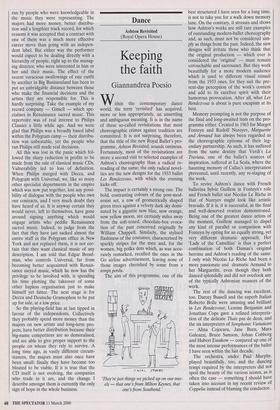Dance
Ashton Revisited (Royal Opera House)
Keeping the faith
Giannandrea Poesio
Within the contemporary dance world, the term 'revisited' has acquired, more or less appropriately, an unsettling and ambiguous meaning. It is in the name of these so-called revisitations that most choreographic crimes against tradition are committed. It is not surprising, therefore, that the title of the new Royal Ballet's pro- gramme, Ashton Revisited, sounds ominous. Fortunately, most of the revisitations are more a second visit to selected examples of Ashton's choreography than a radical re- reading of the same; the only radical novel- ties are the new designs for the 1933 ballet Les Rendezvous, with which the evening kicks off.
The impact is certainly a strong one. The bold, contrasting colours of the post-mod- ernist set, a row of geometrically shaped green trees against a velvety dark sky domi- nated by a gigantic now blue, now orange, now yellow moon, are certainly miles away from the soft-toned, chocolate-box evoca- tion of the past conceived originally by William Chappell. Similarly, the stylised flashiness of the costumes, characterised by sparkly stripes for the men and, for the women, big polka dots which, as was accu- rately remarked, recalled the ones in the Go airline advertisement, leaving none of those images cherished by some from a temps perdu.
The aim of this programme, one of the `They're just things we picked up on our trav- els — that one's from Milton Keynes, that one's from Southend.' best structured I have seen for a long time, is not to take you for a walk down memory lane. On the contrary, it stresses and shows how Ashton's works are still rare examples of outstanding modern-ballet choreography and, as such, must not be considered sim- ply as things from the past. Indeed, the new designs will irritate those who think that the original production — which ever is considered the 'original' — must remain untouchable and sacrosanct. But they work beautifully for a more modern audience which is used to different visual stimuli from the 1933 ones, for they suit the pre- sent-day perception of the work's content and add to its carefree spirit with their humorous provocation. After all, what Les Rendezvous is about is pure escapism at its best.
Memory prompting is not the purpose of the final and long-awaited item on the pro- gramme either. Created in 1963 for Margot Fonteyn and Rudolf Nureyev, Marguerite and Armand has always been regarded as the choreographic epitome of their leg- endary partnership. As such, it has suffered from the same destiny that Verdi's La Traviata, one of the ballet's sources of inspiration, suffered at La Scala, where the haunting memory of Callas's interpretation prevented, until recently, any re-staging of the work.
To revive Ashton's dance with French ballerina Sylvie Guillem in Fonteyn's role and French ballet star Nicolas Le Riche in that of Nureyev might look like artistic bravado. If it is, it is successful, as the final and well-deserved ovation demonstrated. Being one of the greatest dance artists of the moment, Guillem managed to dispel any kind of parallel or comparison with Fonteyn by opting for an equally strong, yet very different dramatic approach. Her `Lady of the Camellias' is thus a perfect combination of both Dumas's original heroine and Ashton's reading of the same. I only wish Nicolas Le Riche had been a more passionate and dramatic Armand to her Marguerite, even though they both danced splendidly and did not overlook any of the typically Ashtonian nuances of the work.
The rest of the dancing was excellent, too. Darcey Bussell and the superb Italian Roberto Bolle were amusing and brilliant in Les Rendezvous; Leanne Benjamin and Jonathan Cope gave a refined interpreta- tion of the delicate Thais pas de deux, and the six interpreters of Symphonic Variations — Alina Cojocaru, Jane Burn, Mara Galeazzi, Bruce Samson, Johan Cobborg and Hubert Essakow — conjured up one of the most intense performances of the ballet I have seen within the last decade.
The orchestra, under Paul Murphy, played beautifully, too, and the dancing tempi required by the interpreters did not spoil the beauty of the various scores, as is often the case — something I should have taken into account in my recent review of Coppelia instead of blaming the conductor.


































































 Previous page
Previous page